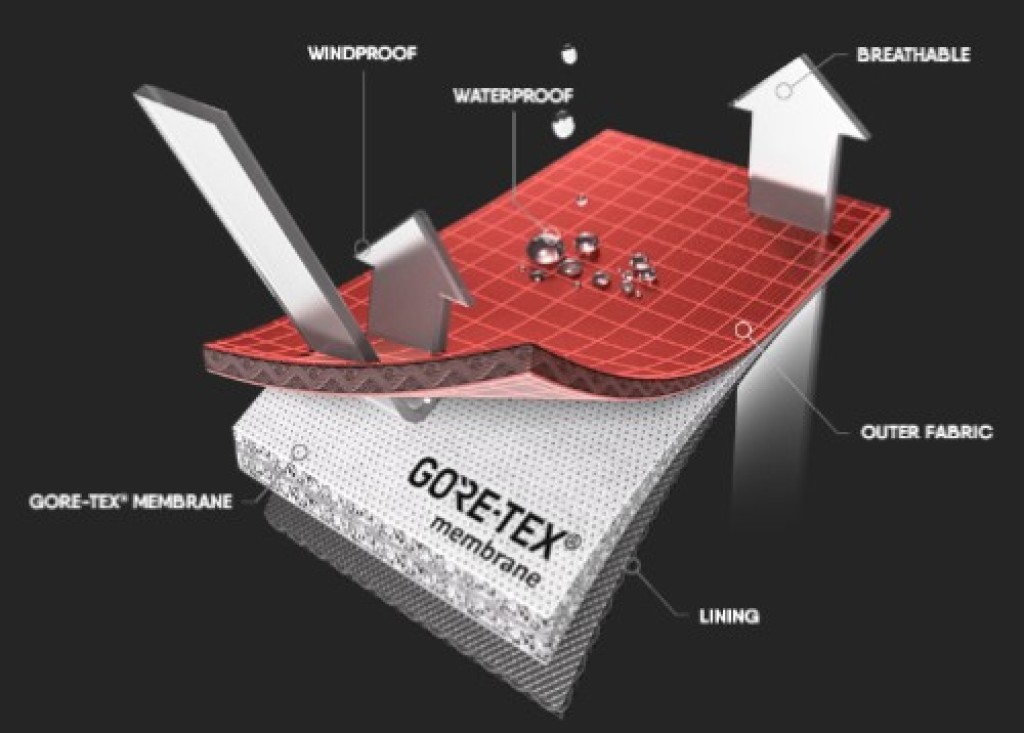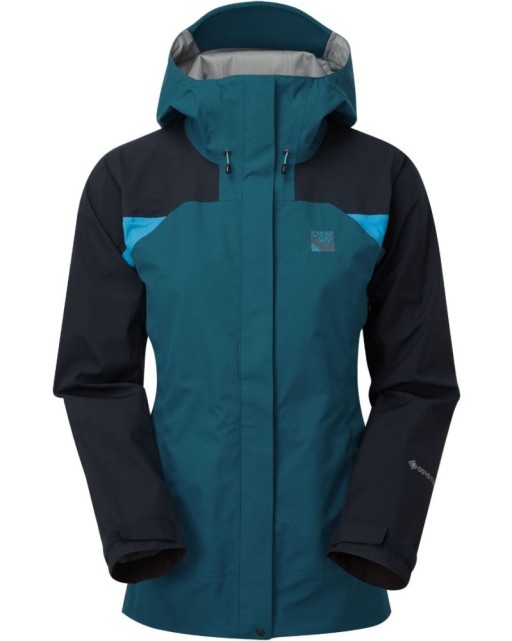 Everyone wants to feel comfortable when hiking in the countryside no matter what the weather. It is important to choose the right outdoor waterproof fabric for your jacket and trousers in order to achieve this. With 18 years of experience in the great outdoors business, Agoora Outdoor are well equipped to give excellent advice on breathable waterproof fabrics for outdoor jackets and trousers.
Everyone wants to feel comfortable when hiking in the countryside no matter what the weather. It is important to choose the right outdoor waterproof fabric for your jacket and trousers in order to achieve this. With 18 years of experience in the great outdoors business, Agoora Outdoor are well equipped to give excellent advice on breathable waterproof fabrics for outdoor jackets and trousers.
Which is the Best Outdoor Waterproof Fabric?
Well, this depends on what you want and how much you want to spend. As anyone who has tried wearing a plastic bin bag as an emergency waterproof jacket will know, stopping the rain is easy, dealing with the moisture from your perspiration is much more difficult. If you are working hard climbing a hill, your clothing can still end up being soaked with perspiration. Hence it is necessary to have a breathable waterproof fabric which allows water vapour to pass through it. This is possible because a water vapour molecule is many thousands of times smaller than the smallest water droplet. So, rainwater can be kept out whilst water vapour from perspiration can escape through microscopic holes in the fabric.
The majority of waterproof breathable fabrics have a face fabric with the rainproof breathable layer underneath. If you want a lightweight waterproof fabric, then clearly, the lightest face fabrics will not last as long as the heavier materials in most cases. Polyamide (often referred to by its tradename of Nylon) is the hardest wearing fabric so is generally favoured for the lightest jackets. Polyester is also hard wearing and tends to be softer than some forms of nylon so is often preferred. Some jackets use waxed cotton but these tend to be the heaviest.
When constructing outdoor waterproof fabrics, the waterproof layer is usually applied to the underside of the face fabric. This is protected from wear on the inside in one of three ways: 1) By a lining such as silky smooth taffeta combined with mesh fabric to aid breathability. This is used on the heavier, longer lasting jackets and is often referred to as a two-layer fabric with a lining. (e.g. Gore-Tex Performance). 2) By a print layer of durable ink which is applied to the inside. This is used for lightweight packable jackets. This is often referred to as 2.5 layers. Clearly, this will not last as long as a lined jacket. 3) Three layer jackets (e.g. Gore-Tex Pro) where a protective layer of fabric is laminated to the inside so it cannot rub on the waterproof layer. Hence, the waterproof layer cannot be worn away until the fabric itself has worn. Hence, for these jackets, the breathable waterproof fabric is likely to last the longest.
Some jackets don’t have a protective layer. This includes some of the lightest weight Gore-Tex packable jackets. In some cases, the waterproof breathable layer is applied to the outside of the face fabric, such as Gore-Tex Shakedry.
So then, what about the waterproof layer itself? Well, before covering that there are three things that need explaining:
- What is the “Hydrostatic Head”? If you take a drainpipe and attach a breathable waterproof fabric securely across the bottom, then fill up the drainpipe with water. The hydrostatic head (HH) is how high the water is before the fabric starts to leak. The typical tent fabric has a hydrostatic head of 3,000 mm or 3 metres high, but for waterproof garments, the level of wear and punishment is much higher so the figure varies between 5,000 mm (5 m) and 30,000 mm (30 m) for the best Gore-Tex. To be considered waterproof a fabric must have a minimum HH of 1.5 m, however, if you sit on such a fabric the pressure from your body weight will cause it to leak. The minimum HH needed to resist your body weight is 3 m. The higher the HH the longer the fabric will last before the waterproofing fails over time.
- What is the “Breathability”? This term refers to the ability of the breathable waterproof fabric to pass water vapour from your perspiring body on the inside to the outside of the jacket. This depends on the weather conditions. It will be less on a wet day when humidity is high and more on a dry day when humidity is low. This can be measured in different ways with differing standards. A common term is the MVTR or Moisture Vapour Transfer Rate which is measured in gm per square metre over 24hrs. Owing to the different methods of measurement there can be some confusion when comparing fabrics as different manufacturers use different units of measurement. Also, Gore-Tex don’t publish their figures so one is left guessing to some extent. The higher the breathability, the less “clamminess” you will experience when wearing the jacket.
- What is the purpose of a DWR? A Durable Water Repellent surface finish is included in any good hiking jacket to prevent the surface fabric from wetting out when it rains. With a good DWR, rainwater will bead up and run off so the fabric stays dry. It is very difficult for a wet fabric to “breath”. For the jacket to be comfortable it needs to allow as much water vapour from perspiration to escape to the outside as possible. A wet fabric is a barrier to this happening. A quality walking jacket will have a DWR, this will wear off over time and will need to be renewed every six months or so depending on how often the jacket is used. This can be achieved using products supplied by NikWax or Grangers.
So then, regarding the waterproof breathable layer, for the majority of cases, there is a choice between a polyurethane layer which is coated on the fabric or an ePTFE membrane which is laminated to the material. Polyurethane (PU) keeps out the water and allows a reasonable level of breathability. The hydrostatic head for a polyurethane layer varies between about 5,000 mm or 5m and 20,000 mm (20 m). The breathability for PU ranges from around 5000 g/sqm/24hrs MVTR to 20,000 g/sqm/24hrs. Alternatively, there are a wide range of ePTFE membranes.
 Poly Tetra Fluoro Ethylene (PTFE ) was first developed by NASA for the space programme and is used in none stick frying pans and for plumbers sealing tape. Then some brain box at Gore had the idea of expanding it, so the e stands for expanded giving expanded PolyTetraFluoroEthylene (ePTFE). They expanded it to give lots of microscopic holes through which water vapour could pass whilst keeping out the much larger rain droplets. The first Gore-Tex membrane was introduced in 1978 and they have been developing and improving it ever since. Their original patent has long since expired so now there are many competitors to Gore-Tex such as eVent. Also, some jacket manufacturers have their own version of an ePTFE membrane.
Poly Tetra Fluoro Ethylene (PTFE ) was first developed by NASA for the space programme and is used in none stick frying pans and for plumbers sealing tape. Then some brain box at Gore had the idea of expanding it, so the e stands for expanded giving expanded PolyTetraFluoroEthylene (ePTFE). They expanded it to give lots of microscopic holes through which water vapour could pass whilst keeping out the much larger rain droplets. The first Gore-Tex membrane was introduced in 1978 and they have been developing and improving it ever since. Their original patent has long since expired so now there are many competitors to Gore-Tex such as eVent. Also, some jacket manufacturers have their own version of an ePTFE membrane.
There are some technical variations between the different membranes owing to the need to protect the microscopic holes from being blocked by dirt and body oils. For example Gore-Tex use a very thin layer of polyurethane (PU) which repels oils (i.e its oleophobic). This also stops the wind completely and is responsible for the very high hydrostatic head of 30 m which is achieved in some versions of Gore-Tex. However, the downside is that the PU layer reduces breathability. Hence some fabrics such as eVent are more breathable than standard Gore-Tex but need to be cleaned regularly in order to maintain performance because, whilst they are treated to repel body oils, this is not as effective as a thin PU coating. Needless to say, there are now numerous versions of Gore-Tex, some of which have very good breathability. Full details can be found on the Gore-Tex website, similarly more information is on the eVent website.
People running Ultra Marathons will be aware of the new Gore-Tex Shakedry jackets where the eptfe membrane is applied to the outside of the lightweight waterproof fabric giving a two-layer construction which does not require a DWR. Rainwater runs straight off so the fabric never wets out, resulting in no chilling effect from evaporation and no weight gain caused be wetting out. Shakedry is also one of the most breathable laminates from Gore-Tex. The drawback of course is that the Shakedry membrane is exposed to wear and tear. For example it would be a mistake to wear a heavy rucksack with this fabric as it would quickly wear off. Lightweight Vest Packs can by worn with minimal contents for Ultra Marathon purposes.
What about PVC fabric? We have all seen those shiny waterproof fashion coats. Well, the problem with PVC is that it isn’t breathable so is “clammy” to wear. Apparently, there is also some evidence to suggest it is bad for your health. So, PVC is generally not used for outdoor applications.
What about Polythene? It is possible to buy cheap polythene ponchos, often at music festivals. Well, that’s OK for an emergency but it’s a bit like wearing a plastic bag, polythene is not breathable so your perspiration can’t escape. At least the sleeveless poncho design allows air to circulate and remove some water vapour but this design isn’t good on a windy day and restricts arm movements. Also your clothes still get wet with perspiration, especially if your walking.
As you may have gathered Gore-Tex is the dominant force in ePTFE membranes for outdoor waterproof fabrics but it is expensive, so people on a budget will settle for a polyurethane layer. Each jacket manufacturer tends to have their own brand name for the polyurethane layer such as Sprayway Hydro/Dry or The North Face DryVent for example. These jackets and trousers cost less than the Gore-Tex ones. Information regarding the hydrostatic head and the fabric breathability is generally given on the swing tags supplied with each waterproof garment. Similarly details regarding the type of Gore-Tex used is generally given on the swing tags or website descriptions if they are detailed enough.
Agoora Outdoor give plenty of details on everything we have on sale including breathability, hydrostatic head, weight, type of material and suggested uses, so why not visit our website using these links:
Mens Waterproof Jackets Womens Waterproof Jackets
Mens Waterproof Trousers Womens Waterproof Trousers
You may also like to see our blogs: How to Spot a Good Waterproof Hiking Jacket and A Guide to Waterproof Walking Trousers (coming soon).








 Change currency
Change currency
 AUD
AUD  CAD
CAD  CHF
CHF  DKK
DKK  EUR
EUR  JPY
JPY  NOK
NOK  NZD
NZD  RUB
RUB  SEK
SEK  USD
USD 





 Poly Tetra Fluoro Ethylene (PTFE ) was first developed by NASA for the space programme and is used in none stick frying pans and for plumbers sealing tape. Then some brain box at Gore had the idea of expanding it, so the e stands for expanded giving expanded PolyTetraFluoroEthylene (ePTFE). They expanded it to give lots of microscopic holes through which water vapour could pass whilst keeping out the much larger rain droplets. The first
Poly Tetra Fluoro Ethylene (PTFE ) was first developed by NASA for the space programme and is used in none stick frying pans and for plumbers sealing tape. Then some brain box at Gore had the idea of expanding it, so the e stands for expanded giving expanded PolyTetraFluoroEthylene (ePTFE). They expanded it to give lots of microscopic holes through which water vapour could pass whilst keeping out the much larger rain droplets. The first